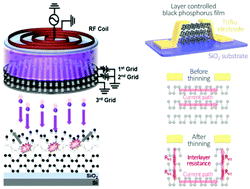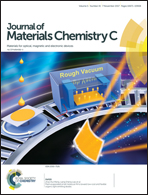Layer-controlled thinning of black phosphorus by an Ar ion beam†
Abstract
Black phosphorus (BP) is one of the most interesting two-dimensional (2D) layered materials due to its unique properties, including a band gap energy change from 0.3 eV (bulk) to 2.0 eV (monolayer) depending on the number of BP layers, for application in nanoelectronic devices. In general, 2D layered materials including BP have limitations in terms of synthesis due to the process factors such as time, temperature, etc., and thus, a thinning technique from the bulk material to a 2D material needs to be used while controlling the removed layer thickness. In this study, layer-controlled thinning of BP was performed by using a controlled Ar+ ion beam method and the BP thinning characteristics were investigated. By using the near monoenergetic ion energy in the range of 45–48 eV, BP could be thinned with the thinning rate of ∼0.55 nm min−1 down to bilayer BP without increasing the surface roughness and without changing the chemical binding states. The BP oxide on the pristine BP could also be successfully removed using the same Ar+ ion beam. 2D BP field-effect transistors (FETs) fabricated with the thinned bilayer–10-layer BPs exhibited electrical characteristics similar to those of pristine BP FETs suggesting no electrical damage on the BP layers thinned by the controlled monoenergetic Ar+ ion beam.



 Please wait while we load your content...
Please wait while we load your content...